AMD EPYC 3101 Benchmarks
For this exercise, we are using our legacy Linux-Bench scripts which help us see cross-platform “least common denominator” results we have been using for years as well as several results from our updated Linux-Bench2 scripts. At this point, our benchmarking sessions take days to run and we are generating well over a thousand data points. We are also running workloads for software companies that want to see how their software works on the latest hardware. As a result, this is a small sample of the data we are collecting and can share publicly. Our position is always that we are happy to provide some free data but we also have services to let companies run their own workloads in our lab, such as with our DemoEval service. What we do provide is an extremely controlled environment where we know every step is exactly the same and each run is done in a real-world data center, not a test bench.
We are going to show off a few results, and highlight a number of interesting data points in this article.
Python Linux 4.4.2 Kernel Compile Benchmark
This is one of the most requested benchmarks for STH over the past few years. The task was simple, we have a standard configuration file, the Linux 4.4.2 kernel from kernel.org, and make the standard auto-generated configuration utilizing every thread in the system. We are expressing results in terms of compiles per hour to make the results easier to read:
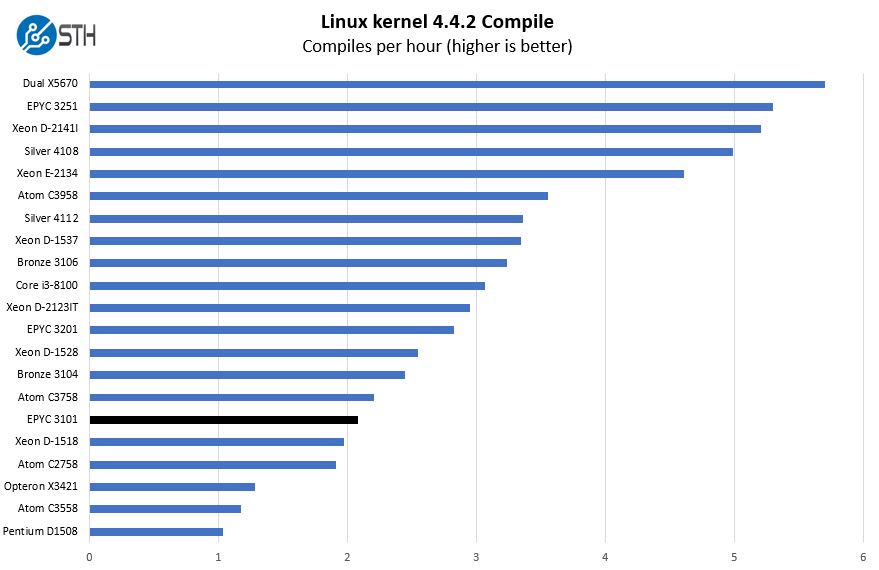
With four cores and four threads, the AMD EPYC 3101 is able to perform between the 4 core/ 8 thread Intel Xeon D-1518 and the 8 core Intel Atom C3758.
c-ray 1.1 Performance
We have been using c-ray for our performance testing for years now. It is a ray tracing benchmark that is extremely popular to show differences in processors under multi-threaded workloads. We are going to use our 4K results which work well at this end of the performance spectrum.
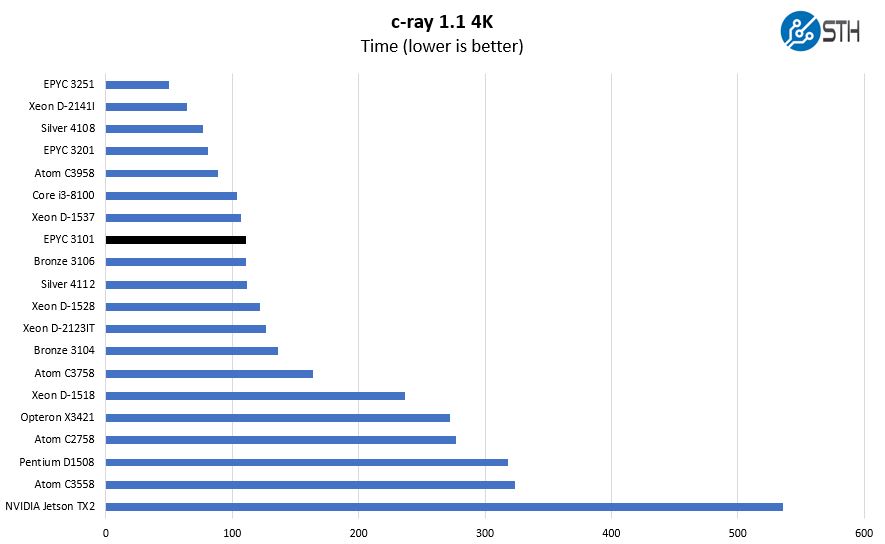
It may look like the 4 core/ 4 thread AMD EPYC 3101 is locked in a dead heat with the 8 core Intel Xeon Bronze 3106. In our 8K results, the Xeon Bronze 3106 pulls slightly ahead. Here the AMD Zen architecture provides an architectural benefit that is exacerbated by the test.
7-zip Compression Performance
7-zip is a widely used compression/ decompression program that works cross-platform. We started using the program during our early days with Windows testing. It is now part of Linux-Bench.
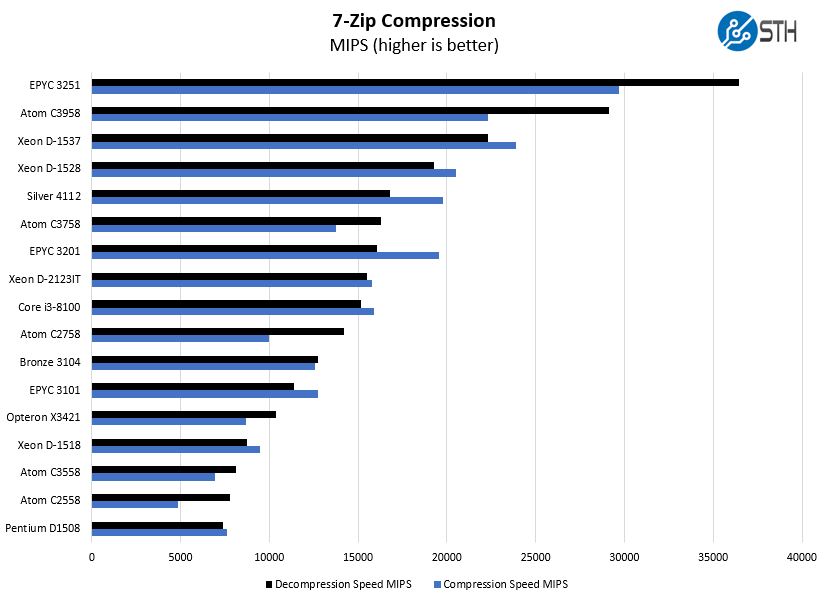
On the 7zip side, we again note that the decompression speed being higher than the compression speed is true for the AMD EPYC 3251 which has SMT at 8 cores and 16 threads. Both the AMD EPYC 3101 (4 cores and 4 threads) and the AMD EPYC 3201 (8 cores and 8 threads) show the opposite relationship with those data bars.
NAMD Performance
NAMD is a molecular modeling benchmark developed by the Theoretical and Computational Biophysics Group in the Beckman Institute for Advanced Science and Technology at the University of Illinois at Urbana-Champaign. Note: we are using this without AVX2 and AVX-512 optimizations. We have those in a related benchmark, our GROMACS workload. More information on the benchmark can be found here. Here are the comparison results for the legacy data set:
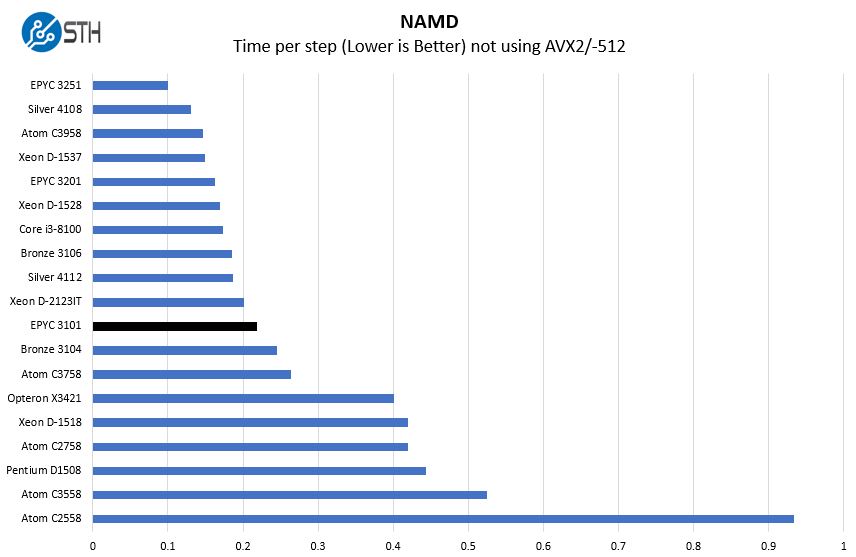
Without the benefit of AVX-512 here, the AMD EPYC 3101 is able to come close to the Intel Xeon D-2123IT in terms of performance. One can also see the impact of the higher-end cores with the substantial lead over the Intel Atom C3758. This is not the type of workload you would run on these systems, but it shows another type of computational prowess.
Sysbench CPU test
Sysbench is another one of those widely used Linux benchmarks. We specifically are using the CPU test, not the OLTP test that we use for some storage testing.
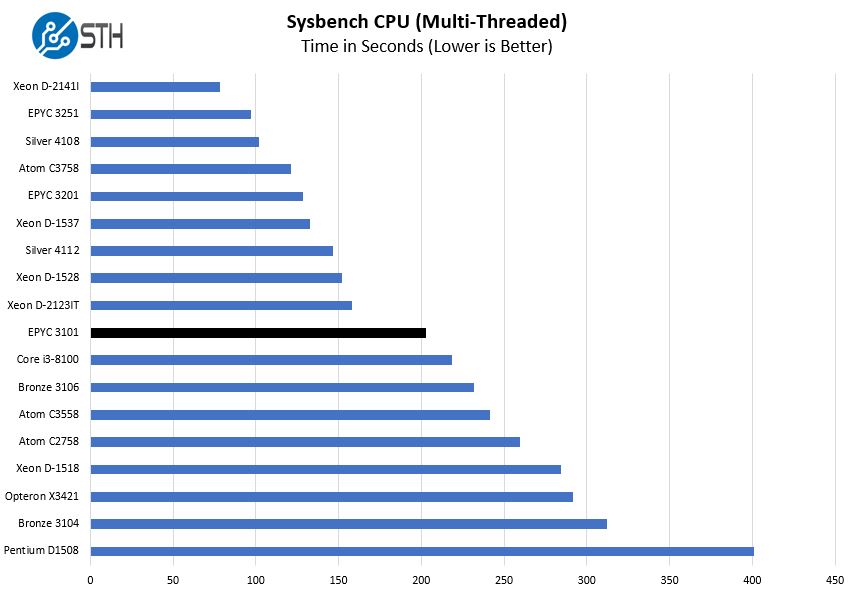
Sysbench is another benchmark that heavily favors AMD Zen versus Intel microarchitectures. That is the key reason why the AMD EPYC 3101 is ahead of the Intel Core i3-8100 here.
OpenSSL Performance
OpenSSL is widely used to secure communications between servers. This is an important protocol in many server stacks. We first look at our sign tests:
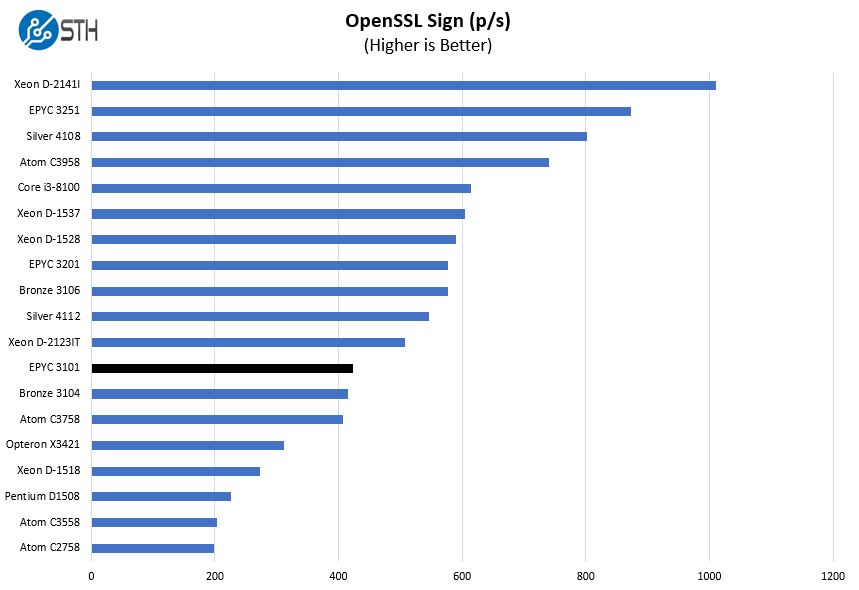
Here are the verify results:
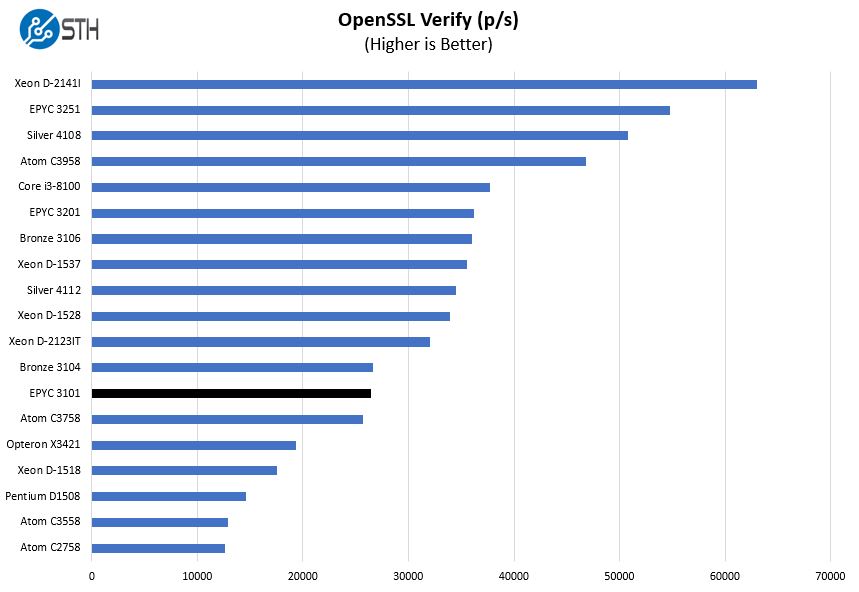
Here we see the performance that is well above the AMD Opteron X3421 and even the Intel Atom 3758. AMD is getting close to Intel Xeon Bronze 3104 performance in only a 35W TDP quad-core part.
UnixBench Dhrystone 2 and Whetstone Benchmarks
Some of the longest-running tests at STH are the venerable UnixBench 5.1.3 Dhrystone 2 and Whetstone results. They are certainly aging, however, we constantly get requests for them, and many angry notes when we leave them out. UnixBench is widely used so we are including it in this data set. Here are the Dhrystone 2 results:
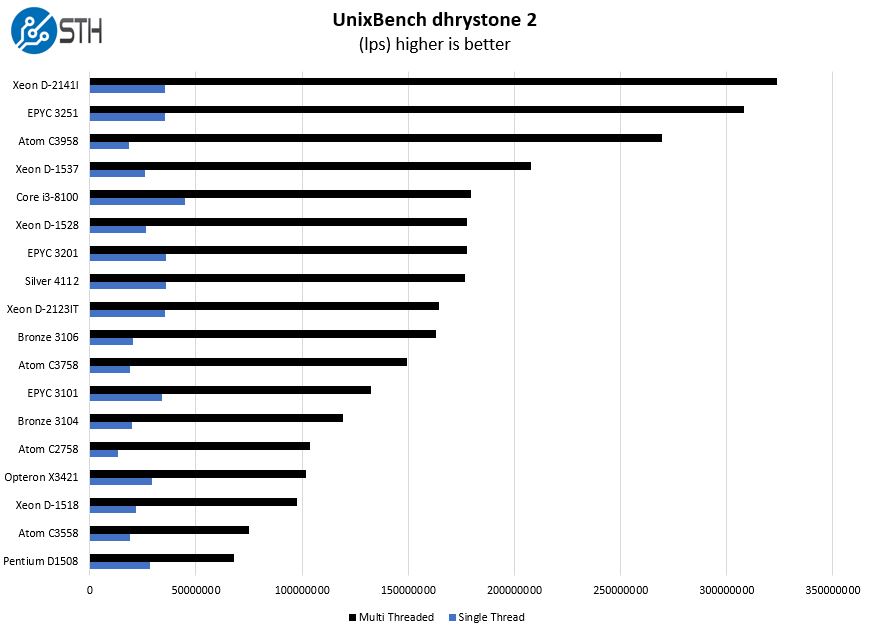
Here are the whetstone results:
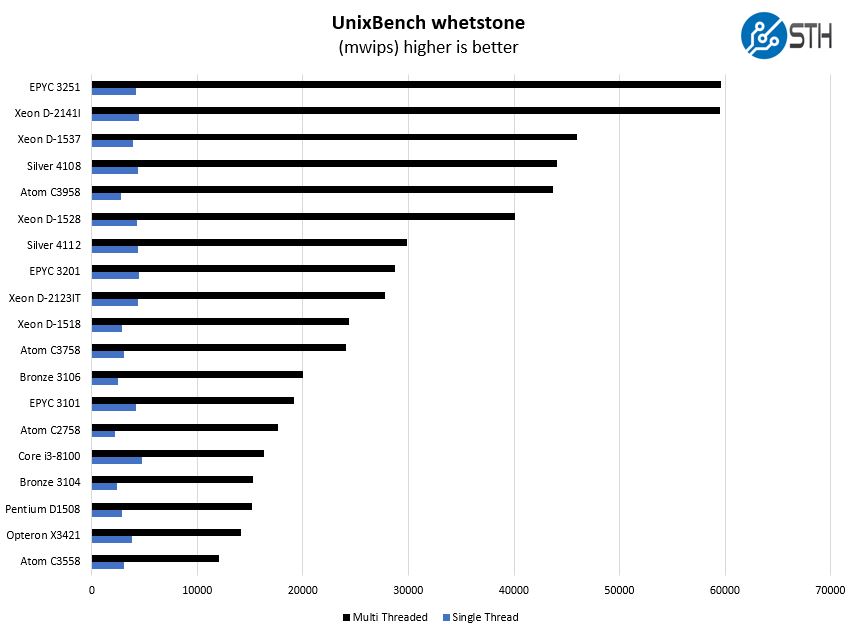
One of the benefits using the larger Zen cores is that single-thread performance is much higher than on lower-end cores like the Intel Atom. That is important because many applications are still single threaded. At 2.9GHz the Turbo clock speed is good for the embedded space. Only a few years ago a 2.9GHz quad-core would be one of the fastest embedded CPUs available.
GROMACS STH Small AVX2/ AVX-512 Enabled
We have a small GROMACS molecule simulation we previewed in the first AMD EPYC 7601 Linux benchmarks piece. In Linux-Bench2 we are using a “small” test for single and dual socket capable machines. Our medium test is more appropriate for higher-end dual and quad socket machines. Our GROMACS test will use the AVX-512 and AVX2 extensions if available.
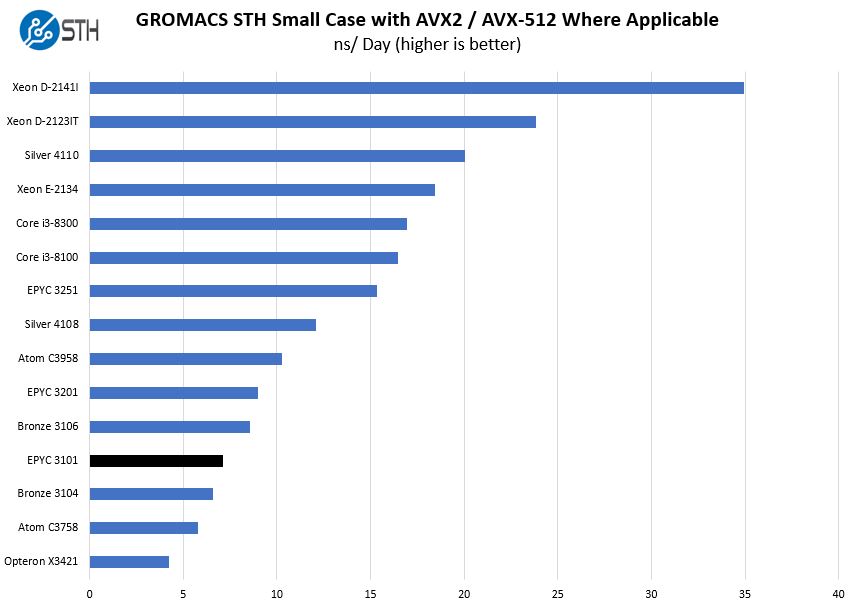
This is from our editor-in-chief, Patrick’s, AMD EPYC 3201 review, and it applies here as well:
This is simply a case where the Intel Xeon D-2100 series family pulls away. Officially the Skylake-D is noted as having single port FMA AVX-512 like the Intel Xeon Bronze, Xeon Silver, and Xeon Gold 5100 series. Clearly, Intel has dual port FMA AVX-512 on the Intel Xeon D-2100 series. I have asked Intel, and nobody will confirm that they are de-featuring the spec sheet, but I have received a “that is a very wise question” when asking it to someone at Intel who should know. (Source: Patrick Kennedy – STH)
Compared to lower-end cores like Intel Atom, AMD still notches a solid win. Likewise, against single port FMA AVX-512 low clock speed parts like the Intel Xeon Bronze 3104, the AMD EPYC 3101 performs well.
Chess Benchmarking
Chess is an interesting use case since it has almost unlimited complexity. Over the years, we have received a number of requests to bring back chess benchmarking. We have been profiling systems and are ready to start sharing results:
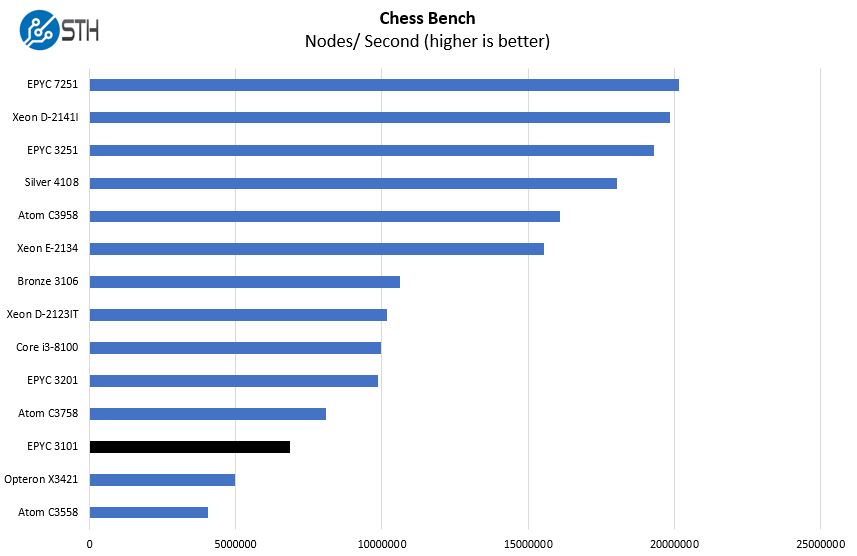
Here the AMD EPYC 3101 shows a case of where having more cores would help. AMD had to stay at 35W TDP with the part and therefore had to make tradeoffs. When we look at the AMD EPYC 3251 here, one can see that there are certainly opportunities for improvement.
Next, we are going to talk AMD EPYC 3101 market positioning before moving on to our final words.




That’s hot. I can’t wait to get a few to test.
I’d be interested in an AMD option that has a feature set similar to the X11SDV-4C-TP8F (Multiple 10GbE, extra 1GbE, lots of SATA ports). I’m hoping ya’ll find something like that to review in the near future.
This isn’t a bad option compared to the mITX Xeon D options though, I hope they also throw in Flex ATX.
Hi Eddie – we have the M11SDV-4C-LN4F in a test rig, but that does not have the features you are looking for, albeit with a faster CPU in this platform. I too hope the line expands, but the X10SDV-F line was one then a second board in the D-1540/ D-1520 days. It is now much larger. My sense is that product lines on new chips in the embedded market take time to develop.
John,
Should M11 be H11?
These will be the M11SDV series.
Well I’m not envious yet, the lack of SATA ports does not make this a good NAS option.
Also dying to know pricing.
Noob about the server type CPUs, but apart from placing those in huge clusters to cut power consumption, bla bla, is there a point for a regular consumer to invest in one of those CPUs? Will it be better or irrelevant or too expensive if this will be in a media server box, streaming music in the house or the web etc
Sorry again for he noobness
I can’t wait idle power consumption tests of this platform product line
I googled and found a heap of info on the M11SDV series and I’ll be damned if I can find any config with either SFP+ ports or more than 4 SATA, rendering the series useless for a NAS.
I want 10GB networking AND more than 4 SATA ports.